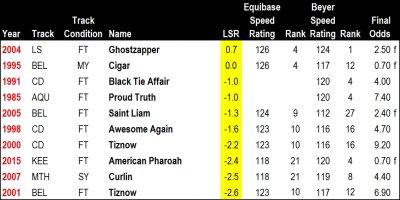By Derek Simon
Prior to the running of this year’s Breeders’ Cup, I took to Twitter — I love the challenge of expressing my innermost thoughts and feelings in 140 characters or less — to post the following:
I wasn’t “hating on” American Pharoah when I wrote this, nor was I questioning his ability. I just felt, given the defections of Beholder and Smooth Roller — two primary pace rivals, if nothing else — that Pharoah was getting the equivalent of a hanging slider in the Classic… and great athletes are expected to crush hanging sliders.
American Pharoah did just that.
In fact, the Triple Crown champ went yard in the Classic, cruising to a 6 ½-length score and leaving no doubt who the best dirt horse in the United States — and, according to Timeform, the world — is (or maybe it’s was now that he’s been retired).
(Click on image to enlarge.)
But how does the son of Pioneerof the Nile rate amongst previous winners of the Breeders’ Cup Classic — Hall of Fame steeds like Cigar, Sunday Silence and Ghostzapper? Well, that is different question altogether and one that speed figures don’t answer satisfactorily.
The aforementioned Timeform, which started rating U.S. horses in 1993, has Pharoah tied with Cigar as the best American racehorse in the past quarter-century… but my hackles are raised when I observe that Arazi, who finished eighth in the 1992 Kentucky Derby and 11th in the BC Mile that same year, is ranked above two-time Horse of the Year Curlin.
Frankly, I haven’t seen a rating that off since a “last call” incident involving me, one too many shots of tequila and what I know believe was a North American Bigfoot.
Equibase went to the other extreme, giving American’s Pharoah’s Classic victory a 118 speed figure, which is tied with Curlin as the 21st best since 1992 (the first year Equibase began assigning such figures).
Meanwhile, the Beyer numbers, which appear in the Daily Racing Form, assert that American Pharoah’s swan song was tied with three others as the fourth-best Classic performance ever.
So whom do we believe?
Well, there’s another way to measure thoroughbred performance — one that is not tied to ratings that can morph over time or that are unduly affected by changing track maintenance procedures or other, similar variables.
For many years, I have used my speed rations — specifically my late speed rations (LSRs) — to assess a horse’s talent in instances where class and track surface are relatively equal and/or consistent. These figures not only measure energy expenditure at a time when the “real” running begins (turning for home), but they are also relative — meaning that they are not reliant on track variants or other man-made constructs.
For example, it is Secretariat’s +3 LSR in the 1973 Kentucky Derby that makes me believe his was the best performance in the modern history of the most exciting two minutes in sports — something that most racing experts and historians readily concur with.
So, how does American Pharoah’s -2 LSR in the Breeders’ Cup Classic compare to other winners of that race? The answer might surprise you.
(Click on image to enlarge.)
According to my numbers, American’s Pharoah’s Classic romp ranks as the eighth-best dirt performance in the history of the event (the 2008 and 2009 editions of the Classic were excluded from consideration, as they were contested over Santa Anita’s since-removed Pro-Ride surface, which was more like turf in the figures it produced).
Not surprisingly, Ghostzapper, whom many consider to be one of the finest thoroughbreds of the 21st century, tops my list, while Cigar, who tied Triple Crown winner Citation’s record of 16 consecutive wins against top-grade company (later surpassed by Zenyatta — although some will argue that the company she faced was less than “top-grade”), ranks second.
1995 Breeders’ Cup Classic
2004 Breeders’ Cup Classic
Frankly, I think that makes perfect sense. I also think it makes sense that the top three BC Classic performances were turned in by horses over the age of three. Numerous studies have revealed that, up until about 4 ½ years of age, horses get faster.
Sadly, we will never know what American Pharoah might have become… but what we saw on the track was pretty darn good.
0 LSR= Excellent.
-5 LSR= Good.
-10 LSR= Fair.
-15 LSR= Poor.







